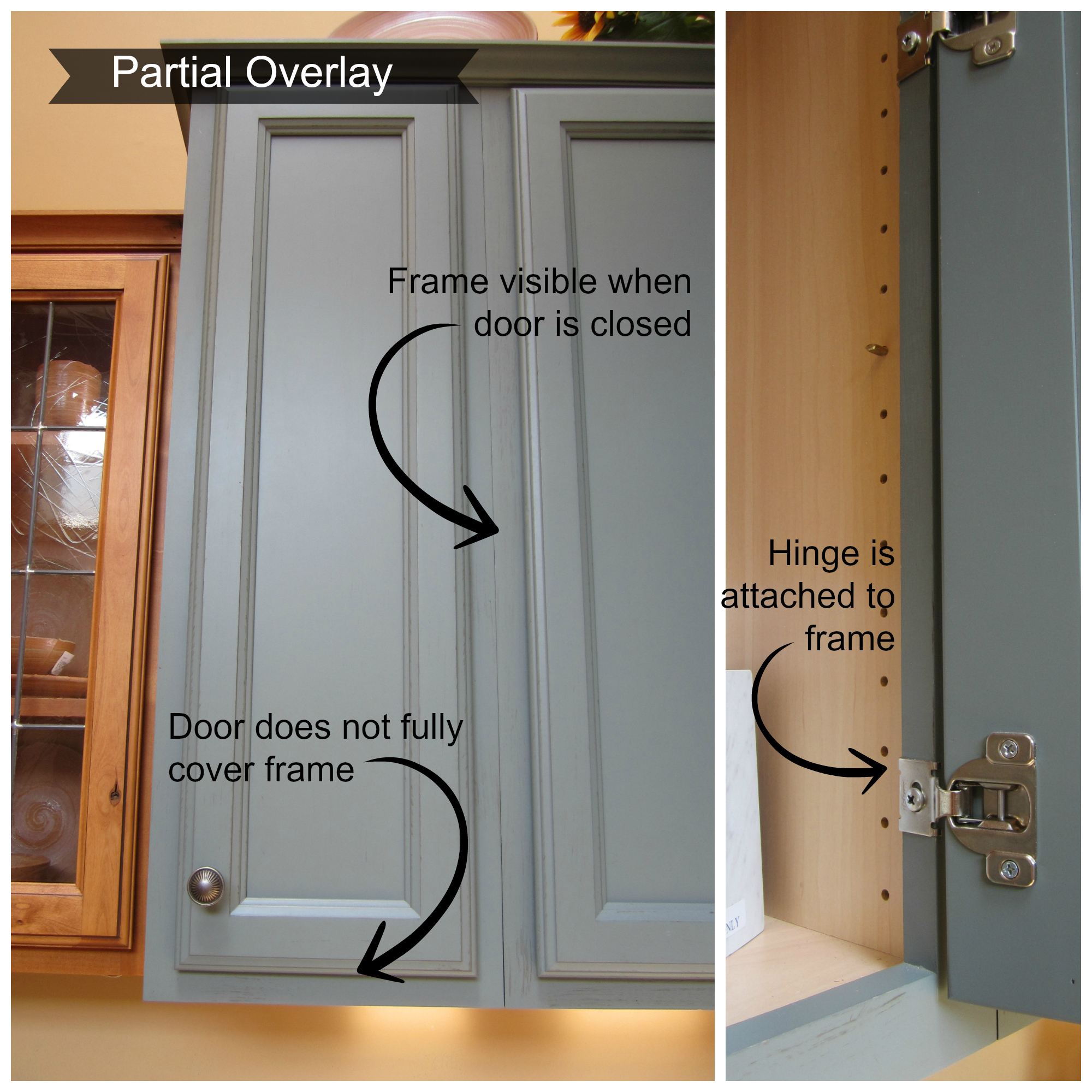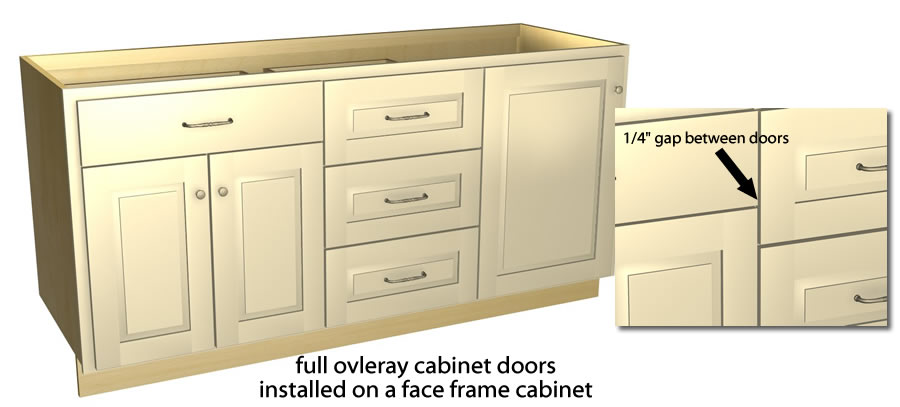Understanding Partial Overlay Shaker Cabinets

Partial overlay shaker cabinets offer a unique blend of traditional charm and contemporary functionality. This style is characterized by its simple, clean lines and subtle design elements, making it a popular choice for various kitchen designs.
Partial Overlay Shaker Cabinet Design
Partial overlay shaker cabinets feature doors that partially cover the cabinet frame, leaving a small gap visible between the door and the adjacent cabinet. This design element distinguishes them from full overlay cabinets, where the doors completely cover the frame, creating a seamless appearance.
Comparison with Full Overlay Cabinets
Partial overlay shaker cabinets differ from full overlay shaker cabinets in several ways. Full overlay cabinets offer a more modern, streamlined look, while partial overlay cabinets provide a more traditional and classic aesthetic. The gap between the doors and the frame in partial overlay cabinets creates a visual separation between the cabinets, adding depth and dimension to the kitchen design.
Aesthetic Appeal of Partial Overlay Shaker Cabinets
Partial overlay shaker cabinets appeal to those who appreciate the timeless elegance of shaker style cabinets but desire a more subtle and understated look. The partial overlay design allows for a touch of visual interest without sacrificing the clean lines and simplicity that define the shaker style. This style complements various kitchen designs, from traditional to contemporary, offering versatility in creating a desired aesthetic.
Benefits and Drawbacks of Partial Overlay Shaker Cabinets
Partial overlay shaker cabinets offer several benefits, including:
- Classic and Timeless Design: The shaker style, combined with the partial overlay design, provides a timeless and elegant look that complements various kitchen designs.
- Visual Interest: The gap between the doors and the frame adds depth and dimension to the kitchen, creating a visually appealing contrast.
- Versatility: This style can be customized with various finishes, hardware, and colors, allowing for a unique and personalized look.
However, partial overlay shaker cabinets also have some drawbacks:
- Limited Storage Space: The gap between the doors and the frame can reduce the usable storage space within the cabinet.
- More Prone to Dust Accumulation: The exposed frame can be more prone to dust accumulation compared to full overlay cabinets.
Construction and Features

Partial overlay shaker cabinets offer a blend of classic style and modern functionality. Their construction involves meticulous craftsmanship and the use of high-quality materials, resulting in durable and aesthetically pleasing cabinets.
Construction Process
The construction process of partial overlay shaker cabinets typically involves several key steps:
- Cabinet Box Construction: The cabinet box is typically made from plywood or particleboard, providing a sturdy base for the cabinet. The sides, top, and bottom are joined using dado joints, dowels, or pocket screws for maximum strength.
- Door and Drawer Construction: Shaker doors and drawers are known for their simple, elegant design. They are typically constructed using a frame-and-panel design, with a raised panel in the center. The frame is often made from solid wood, while the panel can be made from plywood, MDF, or solid wood.
- Hardware Installation: After the cabinet box, doors, and drawers are constructed, hardware is installed. This includes hinges, drawer slides, knobs, and pulls. The type of hardware used can significantly impact the functionality and aesthetics of the cabinets.
- Finishing: The final step involves finishing the cabinets. This may include sanding, priming, and painting or staining. The finish protects the cabinets from damage and enhances their appearance.
Materials
A variety of materials are used in the construction of partial overlay shaker cabinets, each contributing to their durability, aesthetics, and functionality.
- Wood: Solid wood, such as maple, cherry, oak, or walnut, is commonly used for the cabinet frames, doors, and drawer fronts. Solid wood provides a natural, durable, and elegant finish.
- Plywood: Plywood is often used for the cabinet box, providing strength and stability. It is also used for the panels of doors and drawers.
- MDF: Medium-density fiberboard (MDF) is a cost-effective alternative to plywood and solid wood. It is often used for panels and drawer boxes.
- Particleboard: Particleboard is another cost-effective option for cabinet boxes. It is made from wood chips or sawdust, bonded together with resin.
Door and Drawer Hardware
Partial overlay shaker cabinets offer a wide range of door and drawer hardware options to complement their design and functionality.
- Hinges: Cabinet hinges come in various styles, including concealed, semi-concealed, and surface-mounted hinges. Concealed hinges are popular for their sleek appearance and ease of use.
- Drawer Slides: Drawer slides provide smooth and effortless operation. Common types include side-mount slides, under-mount slides, and full-extension slides. Full-extension slides allow for easy access to the entire drawer contents.
- Knobs and Pulls: Knobs and pulls add the finishing touch to shaker cabinets. They are available in various styles, materials, and finishes to complement the overall design.
Finishes
The finish of partial overlay shaker cabinets plays a significant role in their overall aesthetic appeal. Common finish options include:
- Paint: Paint is a popular finish for shaker cabinets, offering a wide range of colors and finishes. Popular paint colors include white, gray, black, and blue.
- Stain: Staining enhances the natural beauty of wood by adding color and depth. Popular stain colors include cherry, walnut, and oak.
- Lacquer: Lacquer provides a durable, glossy finish that protects the wood from scratches and stains.
- Polyurethane: Polyurethane is a durable, water-resistant finish that is often used for high-traffic areas.
Applications and Design Considerations

Partial overlay shaker cabinets offer a unique blend of traditional elegance and contemporary functionality, making them suitable for a wide range of kitchen styles. Understanding their applications and design considerations allows homeowners to create a kitchen that is both visually appealing and practically efficient.
Kitchen Style Suitability
Partial overlay shaker cabinets seamlessly integrate into various kitchen styles, adding a touch of sophistication and versatility.
- Traditional Kitchens: Partial overlay shaker cabinets complement the classic charm of traditional kitchens. Their clean lines and simple design enhance the warmth and elegance of traditional elements like crown molding, beadboard, and farmhouse sinks.
- Transitional Kitchens: These cabinets bridge the gap between traditional and contemporary styles. Their understated elegance blends well with modern elements like stainless steel appliances and sleek countertops, creating a harmonious and inviting atmosphere.
- Contemporary Kitchens: Partial overlay shaker cabinets can even add a touch of warmth and character to contemporary kitchens. Their simple design complements the clean lines and minimalist aesthetic of modern spaces, providing a balance between sleekness and traditional appeal.
Design Considerations for Integration
Integrating partial overlay shaker cabinets into different spaces requires careful consideration of design elements.
- Cabinet Size and Layout: The size and layout of the cabinets should be carefully planned to maximize space utilization and create a functional work triangle. For example, tall cabinets can provide ample storage space in smaller kitchens, while island cabinets can serve as a focal point in larger kitchens.
- Color and Finish: The color and finish of the cabinets play a crucial role in setting the overall tone of the kitchen. Neutral colors like white, gray, and beige create a clean and timeless look, while bolder colors like navy blue or emerald green add a touch of personality.
- Hardware: The choice of hardware can significantly impact the overall style of the kitchen. Traditional kitchens often feature ornate knobs and pulls, while contemporary kitchens may opt for sleek and minimalist handles.
- Countertops and Backsplash: The countertops and backsplash should complement the cabinets, creating a cohesive and visually appealing design. Natural stone countertops like granite or marble provide a classic look, while quartz or laminate countertops offer durability and affordability.
Innovative Applications
Partial overlay shaker cabinets offer a wealth of possibilities for innovative kitchen design.
- Open Shelving: Incorporating open shelving with partial overlay shaker cabinets adds a touch of modern flair while providing easy access to frequently used items.
- Integrated Appliances: Seamlessly integrating appliances, such as ovens or refrigerators, into the cabinet design creates a sleek and streamlined look.
- Accent Colors and Finishes: Utilizing accent colors or finishes on individual cabinets or doors adds a touch of personality and visual interest to the kitchen.
Design Guide for Hardware and Finishes
Selecting the right hardware and finishes is essential for achieving the desired aesthetic for partial overlay shaker cabinets.
- Traditional Kitchens: For a traditional look, opt for ornate knobs or pulls in finishes like brushed nickel, oil-rubbed bronze, or polished brass.
- Transitional Kitchens: Transitional kitchens often feature a blend of traditional and modern elements. Consider using knobs or pulls with a simple design in finishes like matte black, satin nickel, or brushed brass.
- Contemporary Kitchens: Contemporary kitchens typically feature sleek and minimalist hardware. Opt for handles with a simple design in finishes like matte black, brushed nickel, or stainless steel.
Partial overlay shaker cabinets, with their clean lines and understated elegance, are a popular choice for home offices. Their minimalist design allows for a focus on functionality and organization, making them ideal for creating a workspace that promotes productivity.
For those seeking a personalized touch, diy home office cabinets offer a unique opportunity to tailor the design and construction to individual needs and aesthetic preferences. The simplicity of the shaker style lends itself well to DIY projects, enabling homeowners to craft cabinets that perfectly complement their existing décor and storage requirements.
Partial overlay shaker cabinets offer a classic and timeless aesthetic, characterized by their simple, recessed panel doors and the subtle reveal of the cabinet box. For those seeking to create these cabinets themselves, a wealth of resources exists, including comprehensive DIY MDF cabinet plans.
These plans provide detailed instructions and cut lists, allowing individuals to build custom shaker cabinets that perfectly fit their space and style preferences. By utilizing MDF, a durable and affordable material, DIYers can achieve professional-looking results with relative ease.
